The 4th of July weekend marked a milestone in the plane build. Final assembly of the tailcone signaled moving the primary shop from the bonus room to the rented garage space. The combined parts are now just to big to get out of the bonus room. So except for small parts prep, the main work will be in the new shop. I will miss the convenience and climate controlled comfort of the bonus room, but this move is a good indicator that progress on the build is steadily moving forward.
I also got word this week from Van’s that the quickbuild wing and fuselage parts will be delivered in two weeks. The logistics are near perfect, as I anticipate being finished with the tailcone about that same time.
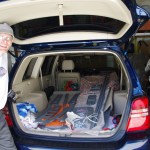 Moving day. Fortunately the roughly 9′ longerons and skins fit just perfectly in Rita’s Highlander with the front seat down. The new shop is only about a mile from the house, but still layers of blankets were used to prevent banging and chipping on the short trip.
Moving day. Fortunately the roughly 9′ longerons and skins fit just perfectly in Rita’s Highlander with the front seat down. The new shop is only about a mile from the house, but still layers of blankets were used to prevent banging and chipping on the short trip.
 Here the bottom pan and left skin are clecoed together ready for riveting.
Here the bottom pan and left skin are clecoed together ready for riveting.
 (Friday, July 3) Sometimes things don’t go just right, despite reading the plans 2-3 times before executing a step. Here we are drilling out a misaligned rudder stop brace for repair.
(Friday, July 3) Sometimes things don’t go just right, despite reading the plans 2-3 times before executing a step. Here we are drilling out a misaligned rudder stop brace for repair.
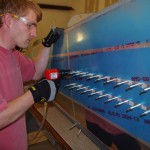
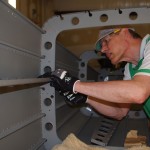 These parts really require two people to process. While a one-man rivet job attaching the skins may theoretically be possible, I cannot imagine the outcome. Here Eric is driving and I am bucking the bottom pan to the bellcrank housing ribs. We completed all the bottom pan rivets for the left side in about 5 hours in the 90 degree heat of the shop. Even with fans going full blast, the heat and humidity were oppressive.
These parts really require two people to process. While a one-man rivet job attaching the skins may theoretically be possible, I cannot imagine the outcome. Here Eric is driving and I am bucking the bottom pan to the bellcrank housing ribs. We completed all the bottom pan rivets for the left side in about 5 hours in the 90 degree heat of the shop. Even with fans going full blast, the heat and humidity were oppressive.
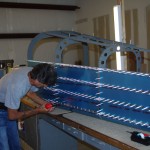
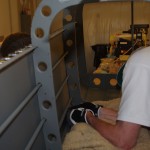 (Saturday, July 4) Rich came over to drive rivets for the left side skins, stiffeners, and frames. Again a two man job, but the results were very good. We started early in the morning to avoid the heat later in the day.
(Saturday, July 4) Rich came over to drive rivets for the left side skins, stiffeners, and frames. Again a two man job, but the results were very good. We started early in the morning to avoid the heat later in the day.
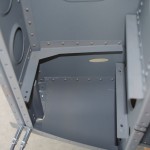 This picture shows the rearmost section with the rudder stop brace on the left. Nice outcome for the repair. I may go back before attaching the right skin to re-prime the scuffed areas and paint the rivet heads. This treatment is really not necessary, but once enclosed, this section will be completly inaccessible. Might as well do it now to avoid concerns about any possible future corrosion.
This picture shows the rearmost section with the rudder stop brace on the left. Nice outcome for the repair. I may go back before attaching the right skin to re-prime the scuffed areas and paint the rivet heads. This treatment is really not necessary, but once enclosed, this section will be completly inaccessible. Might as well do it now to avoid concerns about any possible future corrosion.